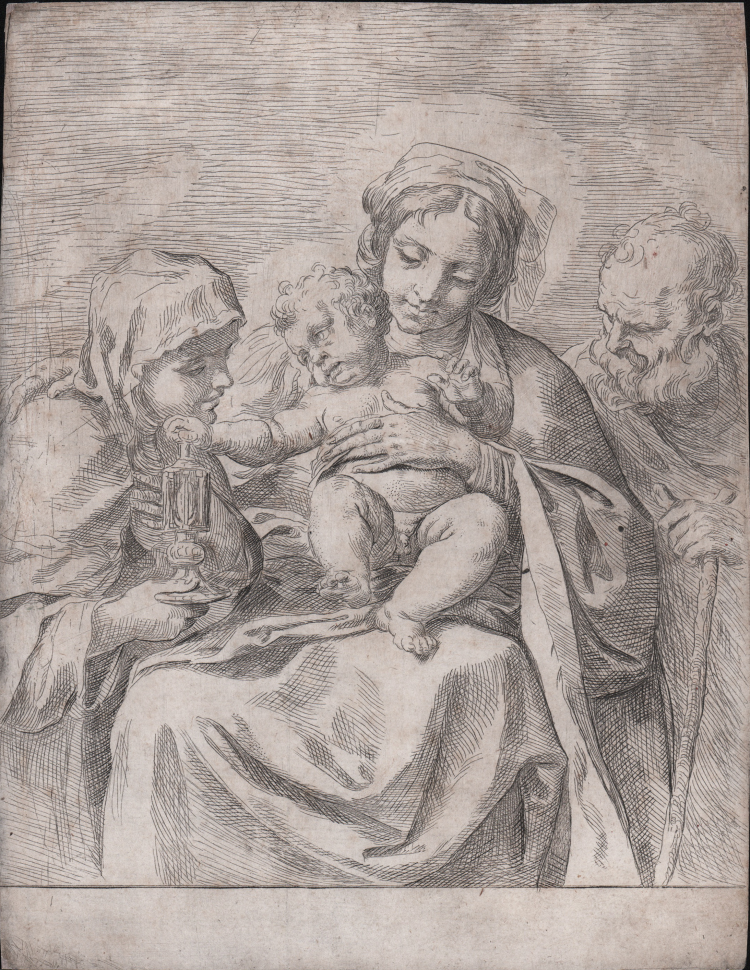




| Reference: | S5215 |
| Author | Guido RENI |
| Year: | 1590 ca. |
| Measures: | 183 x 215 mm |



| Reference: | S5215 |
| Author | Guido RENI |
| Year: | 1590 ca. |
| Measures: | 183 x 215 mm |
Etching, circa 1590/1600, without signature and printing details.
A first state of four described by Birke (TIB), before the Van Aelst imprint.
“Bartsch distinguishes three states, a first without any inscription, a second with Nicolo van Aelst's address, and a third with a reference to Annibale Carracci but no publisher's address. The same distinctions were made by Nagler and Le Blanc. Impressions in Dresden and Parma indicate that another state of this print exists, which bears van Aelst's name as well as a reference to Annibale (S3). On the basis of the publishers's address of van Aelst, who died in Rome in 1613, it seems clear that this is the terminus ante quem for this etching. Carracci's influence, which Pepper also refers to, limits the date more precisely - the last years of the sixteenth century - Annibale arrived in Rome in 1596 - or the beginning of the seventeenth century, and remained until 1613. In this connection, Pepper mentions a drawing by Agostino in the Albertina, in which the Holy Family appears with St. Francis, who kisses the Child's hand. J.T. Prestel's reproductive print (dated 1779) of this drawing, states that Annibale was its author. This indication could speak for its close relationship to Annibale's graphics. The attribution to Reni rests primarily on the opinion of Bartsch whom Nagler and Le Blanc followed. From a stylistic point of view however, the sheet has no convincing slot in the chronological sequence of Reni's prints neither before 1600 - years under Parmigianino’s influence - nor after, while Reni worked in Rome during the first decade of the seventeenth century” (cf. Veronica Birke, Guido Reni in “The Illustrated Bartsch 40 (Commentary), 1987, pp. 349-351, n. 041).
A very good impression, on contemporary laid paper, trimmed to the platemark, good condition.
Bibliografia
Bartsch, Le Peintre graveur (XVIII.303.50); Veronica Birke, Guido Reni in “The Illustrated Bartsch 40 (Commentary), 1987, pp. 349-351, n. 041, I/IV; Nagler n. 50; Le Blanc n. 14; Pepper, Stephen. 1968. Guido Reni's Early Drawing Style, Master Drawings, vol. 6. no. 4, p. 364.
Guido RENI (Calvenzano 1575 - Bologna 1642)
|
A famous painter, he was nearly deified by French and English artistic literature of XVIII and XIX centuries. His first graphic works kept strict to Parmigianino’s art. Moreover, in Rome he copied the painter’s plates depicting the Deposizione and the Armi della famiglia Sforza. Parmigianino’s influence can be found all along his artistic life, especially in the gentleness of his Madonne col Bambino and the Sacre Famiglie.
It is also important to remind the contribution young Guido gave in 1603 for the realization of the funeral service of Agostino Carracci in Bologna, which has the same style of the series of engravings Reni realized when Pope Clemente VIII of the Aldobrandini’s family entered in Bologna.
His graphic acrtivity played a smaller role in his pictorial production and was mainly about religious subjects. He was in fact convinced that he could intensify and widespread the religious and emotional aspects of the Counter-Reformation in his works.
|
Guido RENI (Calvenzano 1575 - Bologna 1642)
|
A famous painter, he was nearly deified by French and English artistic literature of XVIII and XIX centuries. His first graphic works kept strict to Parmigianino’s art. Moreover, in Rome he copied the painter’s plates depicting the Deposizione and the Armi della famiglia Sforza. Parmigianino’s influence can be found all along his artistic life, especially in the gentleness of his Madonne col Bambino and the Sacre Famiglie.
It is also important to remind the contribution young Guido gave in 1603 for the realization of the funeral service of Agostino Carracci in Bologna, which has the same style of the series of engravings Reni realized when Pope Clemente VIII of the Aldobrandini’s family entered in Bologna.
His graphic acrtivity played a smaller role in his pictorial production and was mainly about religious subjects. He was in fact convinced that he could intensify and widespread the religious and emotional aspects of the Counter-Reformation in his works.
|